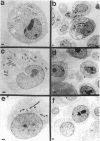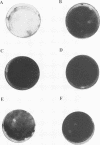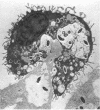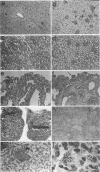Abstract
We have explored the relatively rapidly growing animal and human pathogen Mycobacterium marinum as an experimental model for mycobacterial pathogenesis. M. marinum, which has a lower temperature for optimal growth than does Mycobacterium tuberculosis, has a much shorter generation time and can be safely studied in ordinary laboratory facilities and examined in multiple animal infection models. We have established an in vitro assay for its interaction with eukaryotic cells and shown that it persists in these cells in a temperature-specific fashion that correlates with its ability to cause disease in vivo at lower temperatures. Additionally, preliminary evidence that M. marinum causes a chronic disease with some features resembling tuberculosis in frogs of the species Rana pipiens is presented.
Full text
PDF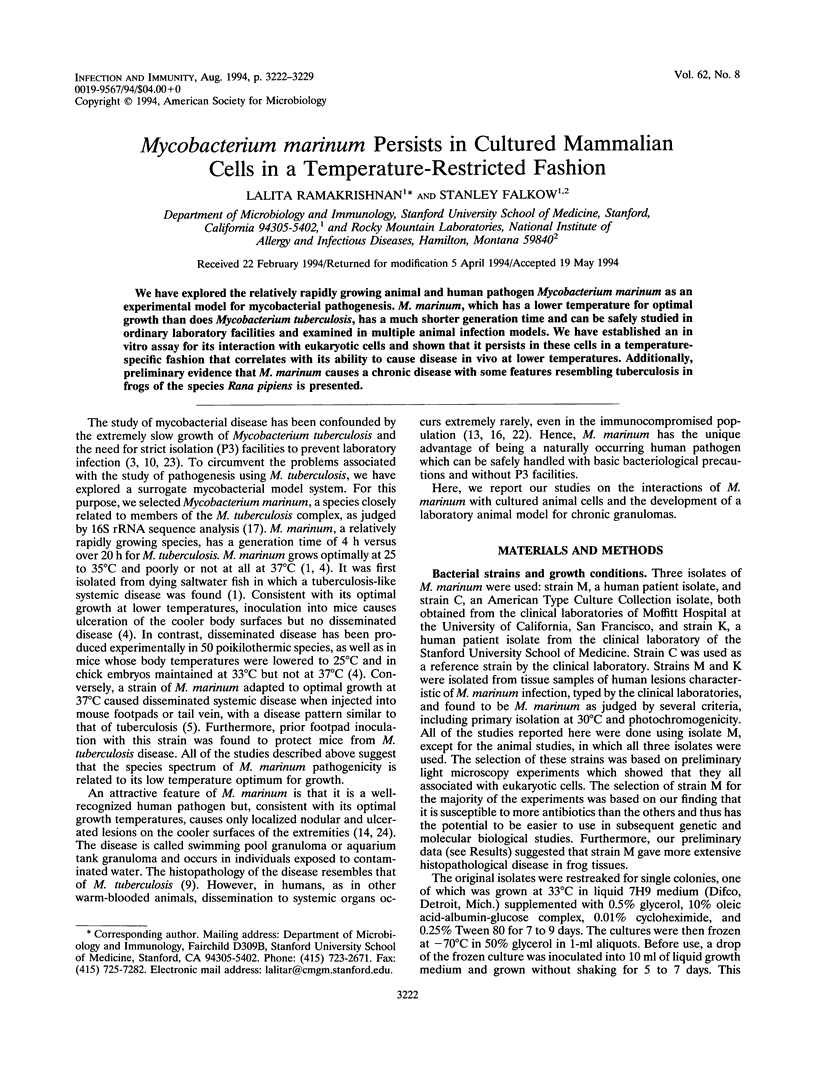
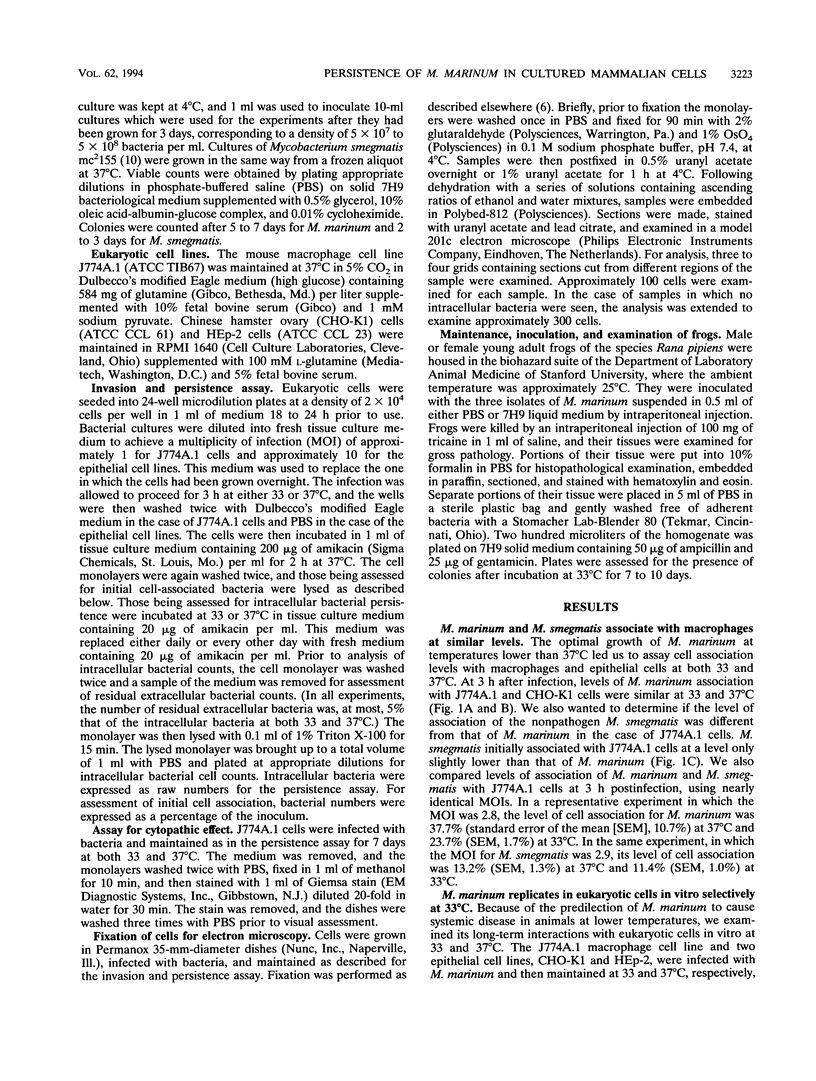
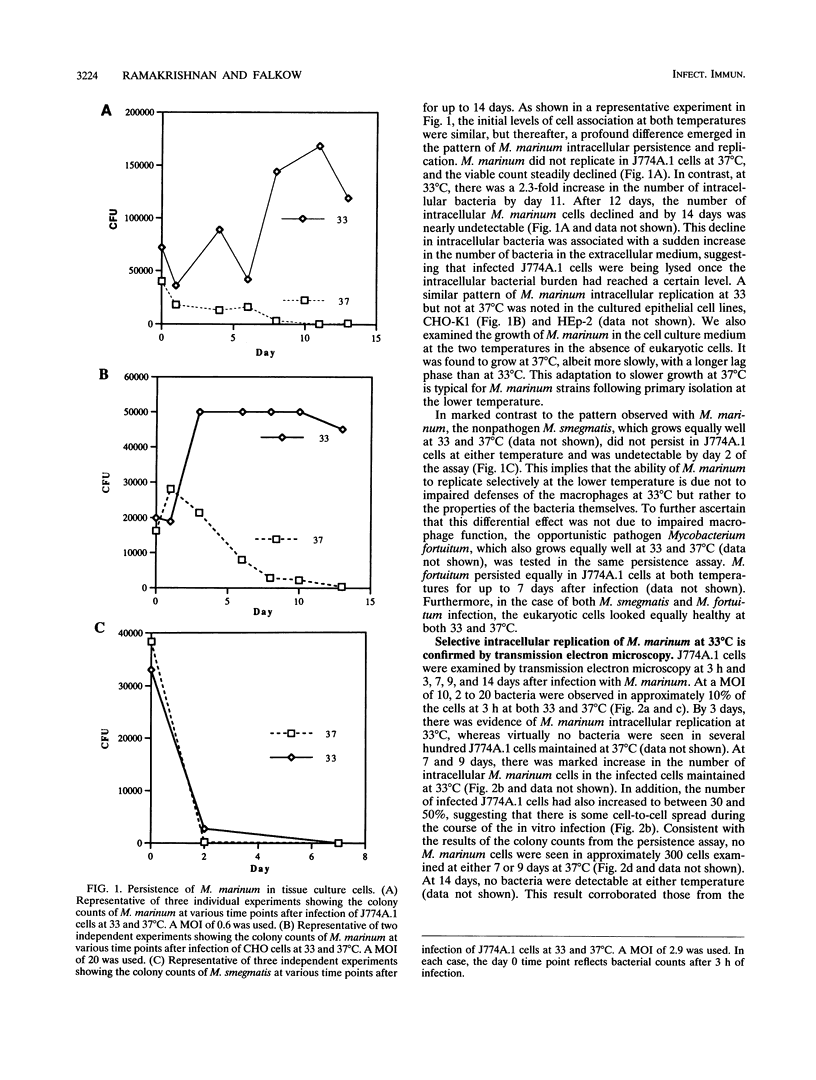
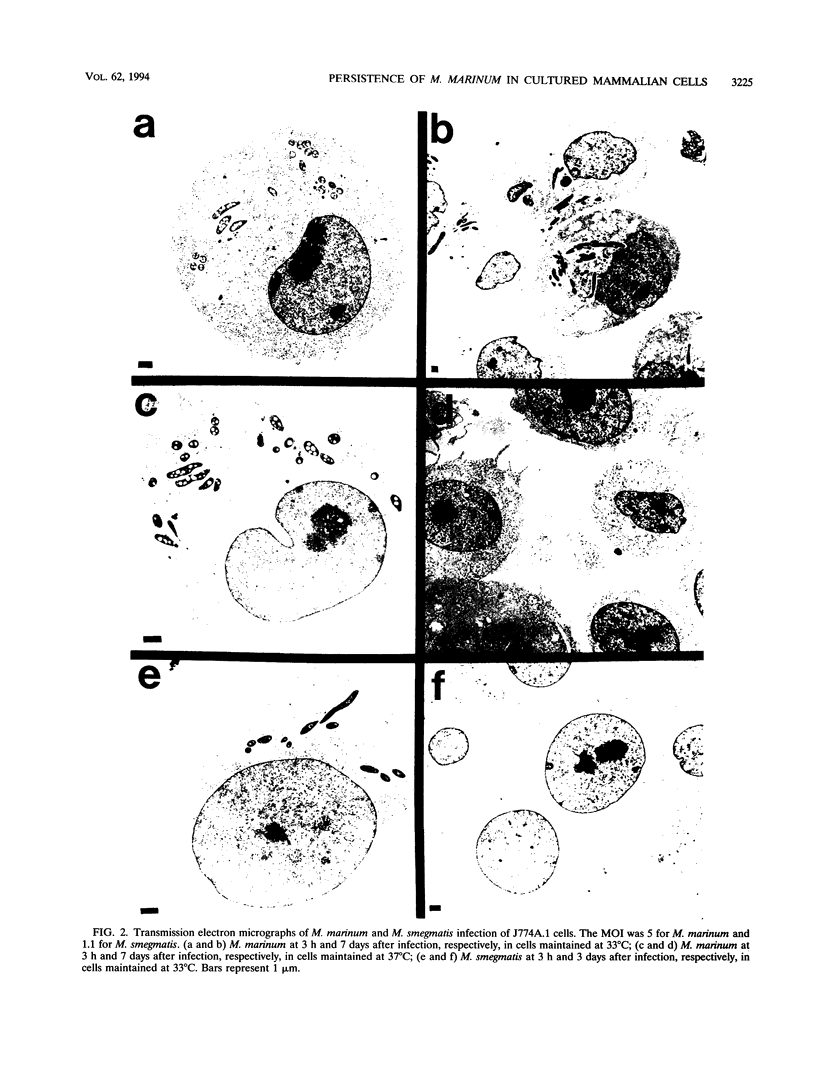
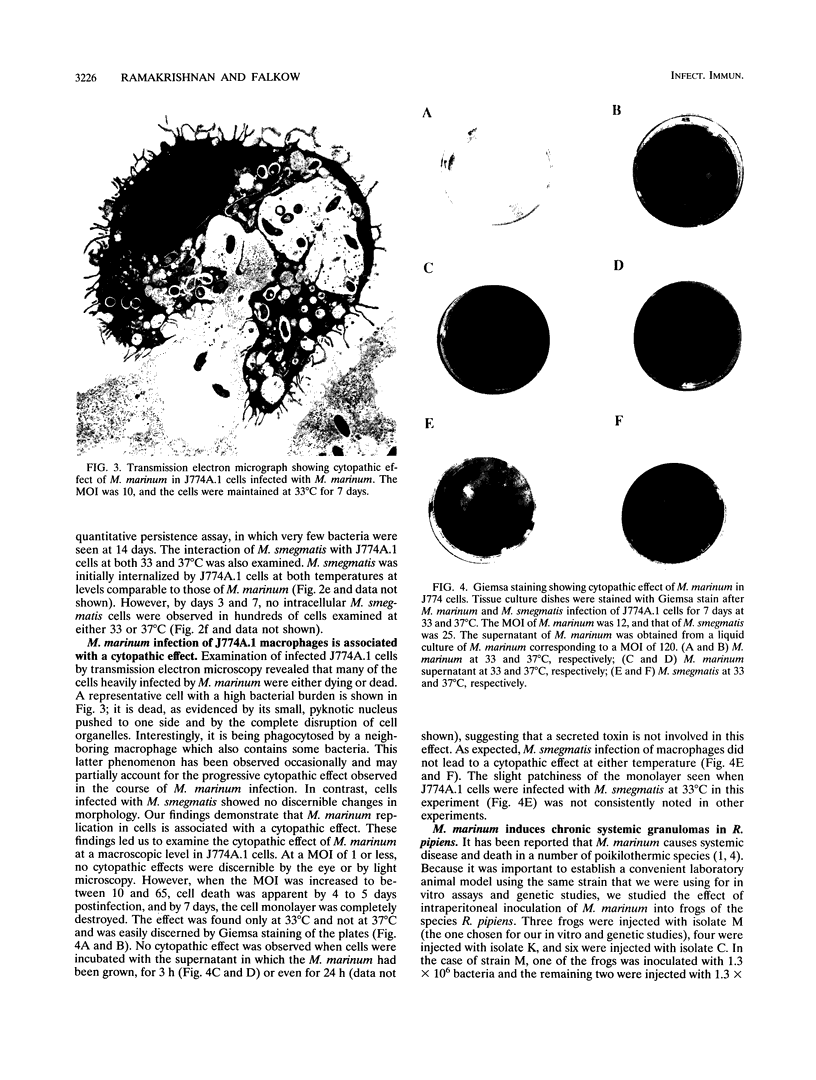
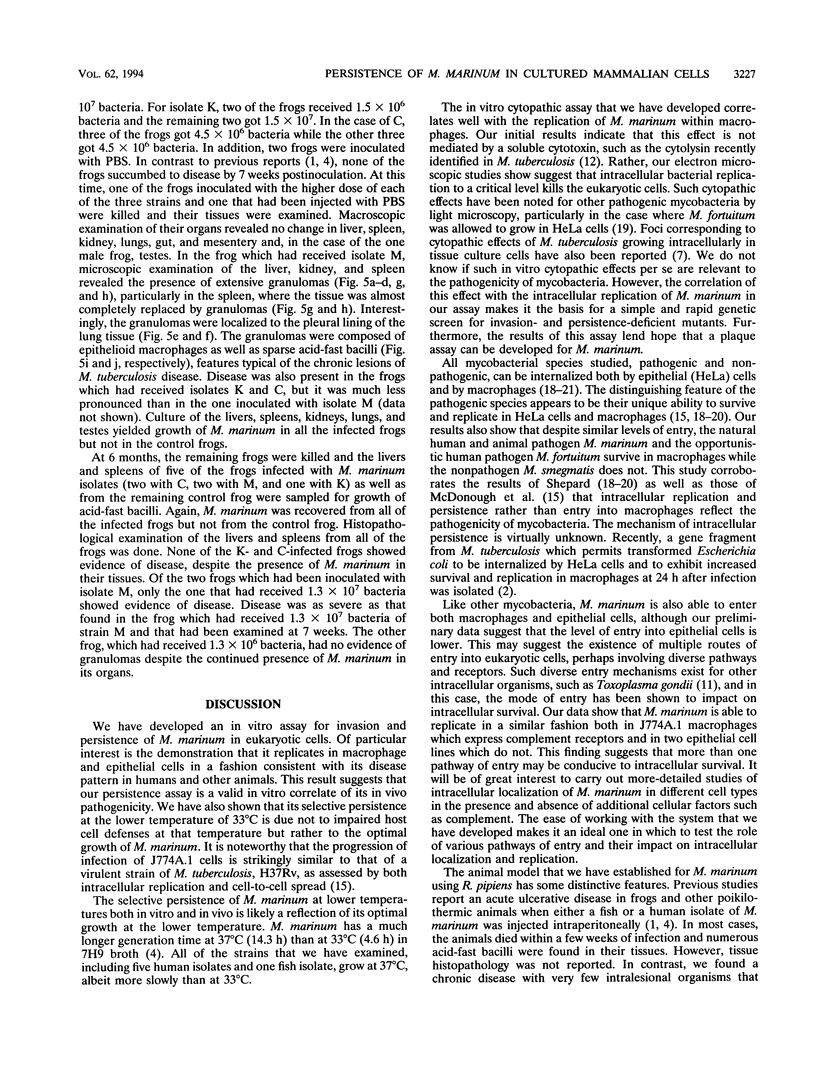
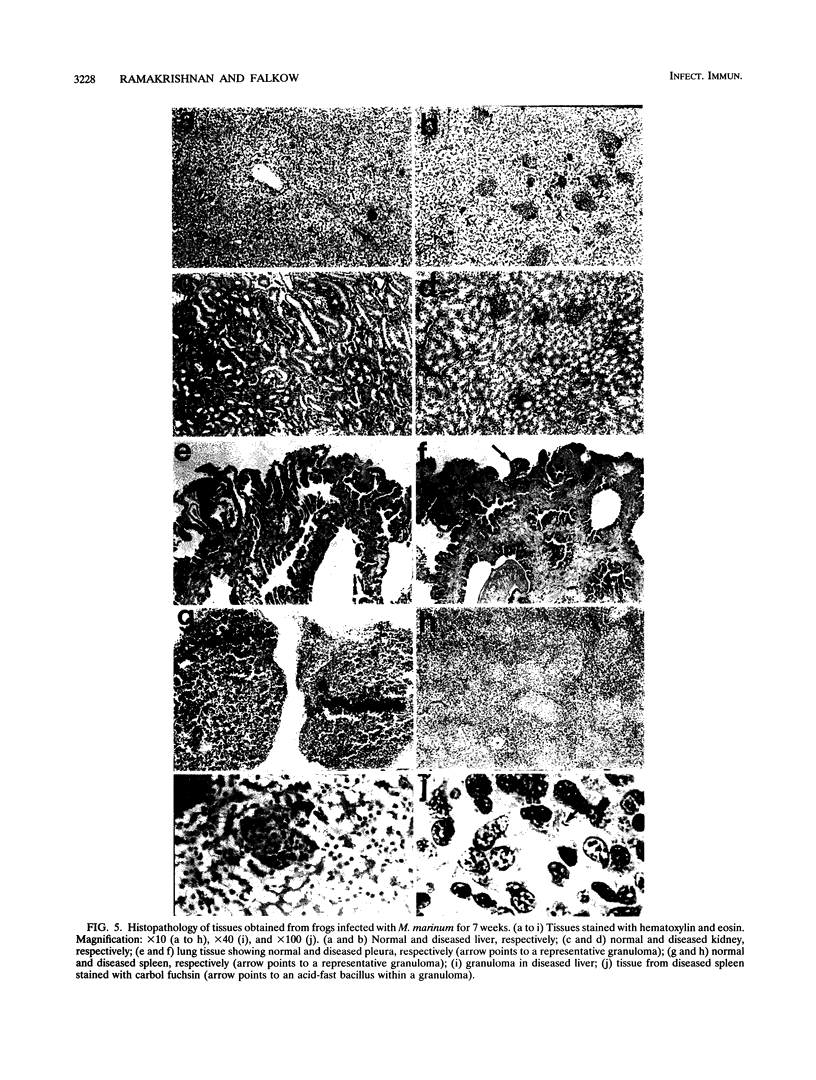
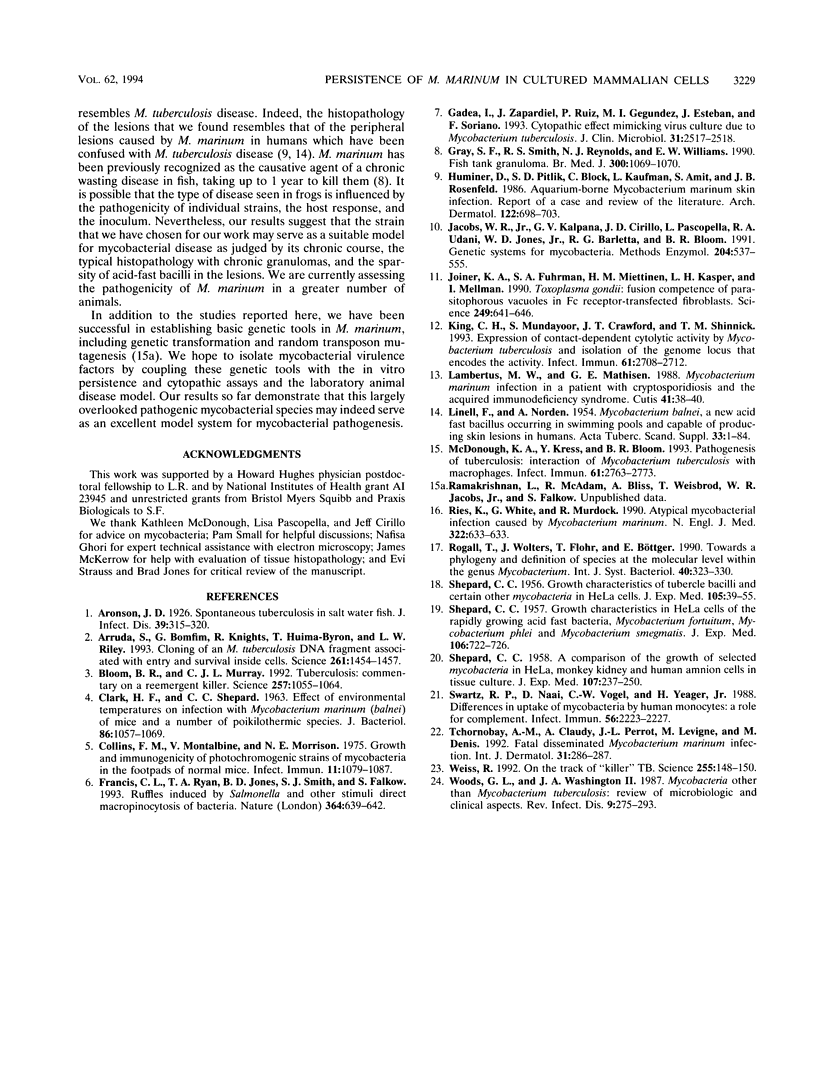
Images in this article
Selected References
These references are in PubMed. This may not be the complete list of references from this article.
- Arruda S., Bomfim G., Knights R., Huima-Byron T., Riley L. W. Cloning of an M. tuberculosis DNA fragment associated with entry and survival inside cells. Science. 1993 Sep 10;261(5127):1454–1457. doi: 10.1126/science.8367727. [DOI] [PubMed] [Google Scholar]
- Bloom B. R., Murray C. J. Tuberculosis: commentary on a reemergent killer. Science. 1992 Aug 21;257(5073):1055–1064. doi: 10.1126/science.257.5073.1055. [DOI] [PubMed] [Google Scholar]
- CLARK H. F., SHEPARD C. C. EFFECT OF ENVIRONMENTAL TEMPERATURES ON INFECTION WITH MYCOBACTERIUM MARINUM (BALNEI) OF MICE AND A NUMBER OF POIKILOTHERMIC SPECIES. J Bacteriol. 1963 Nov;86:1057–1069. doi: 10.1128/jb.86.5.1057-1069.1963. [DOI] [PMC free article] [PubMed] [Google Scholar]
- Collins F. M., Montalbine V., Morrison N. E. Growth and immunogenicity of photochromogenic strains of mycobacteria in the footpads of normal mice. Infect Immun. 1975 May;11(5):1079–1087. doi: 10.1128/iai.11.5.1079-1087.1975. [DOI] [PMC free article] [PubMed] [Google Scholar]
- Francis C. L., Ryan T. A., Jones B. D., Smith S. J., Falkow S. Ruffles induced by Salmonella and other stimuli direct macropinocytosis of bacteria. Nature. 1993 Aug 12;364(6438):639–642. doi: 10.1038/364639a0. [DOI] [PubMed] [Google Scholar]
- Gadea I., Zapardiel J., Ruiz P., Gegúndez M. I., Esteban J., Soriano F. Cytopathic effect mimicking virus culture due to Mycobacterium tuberculosis. J Clin Microbiol. 1993 Sep;31(9):2517–2518. doi: 10.1128/jcm.31.9.2517-2518.1993. [DOI] [PMC free article] [PubMed] [Google Scholar]
- Gray S. F., Smith R. S., Reynolds N. J., Williams E. W. Fish tank granuloma. BMJ. 1990 Apr 21;300(6731):1069–1070. doi: 10.1136/bmj.300.6731.1069. [DOI] [PMC free article] [PubMed] [Google Scholar]
- Huminer D., Pitlik S. D., Block C., Kaufman L., Amit S., Rosenfeld J. B. Aquarium-borne Mycobacterium marinum skin infection. Report of a case and review of the literature. Arch Dermatol. 1986 Jun;122(6):698–703. [PubMed] [Google Scholar]
- Jacobs W. R., Jr, Kalpana G. V., Cirillo J. D., Pascopella L., Snapper S. B., Udani R. A., Jones W., Barletta R. G., Bloom B. R. Genetic systems for mycobacteria. Methods Enzymol. 1991;204:537–555. doi: 10.1016/0076-6879(91)04027-l. [DOI] [PubMed] [Google Scholar]
- Joiner K. A., Fuhrman S. A., Miettinen H. M., Kasper L. H., Mellman I. Toxoplasma gondii: fusion competence of parasitophorous vacuoles in Fc receptor-transfected fibroblasts. Science. 1990 Aug 10;249(4969):641–646. doi: 10.1126/science.2200126. [DOI] [PubMed] [Google Scholar]
- King C. H., Mundayoor S., Crawford J. T., Shinnick T. M. Expression of contact-dependent cytolytic activity by Mycobacterium tuberculosis and isolation of the genomic locus that encodes the activity. Infect Immun. 1993 Jun;61(6):2708–2712. doi: 10.1128/iai.61.6.2708-2712.1993. [DOI] [PMC free article] [PubMed] [Google Scholar]
- LINELL F., NORDEN A. Mycobacterium balnei, a new acid-fast bacillus occurring in swimming pools and capable of producing skin lesions in humans. Acta Tuberc Scand Suppl. 1954;33:1–84. [PubMed] [Google Scholar]
- Lambertus M. W., Mathisen G. E. Mycobacterium marinum infection in a patient with cryptosporidiosis and the acquired immunodeficiency syndrome. Cutis. 1988 Jul;42(1):38–40. [PubMed] [Google Scholar]
- McDonough K. A., Kress Y., Bloom B. R. Pathogenesis of tuberculosis: interaction of Mycobacterium tuberculosis with macrophages. Infect Immun. 1993 Jul;61(7):2763–2773. doi: 10.1128/iai.61.7.2763-2773.1993. [DOI] [PMC free article] [PubMed] [Google Scholar]
- Ries K. M., White G. L., Jr, Murdock R. T. Atypical mycobacterial infection caused by Mycobacterium marinum. N Engl J Med. 1990 Mar 1;322(9):633–633. [PubMed] [Google Scholar]
- Rogall T., Wolters J., Flohr T., Böttger E. C. Towards a phylogeny and definition of species at the molecular level within the genus Mycobacterium. Int J Syst Bacteriol. 1990 Oct;40(4):323–330. doi: 10.1099/00207713-40-4-323. [DOI] [PubMed] [Google Scholar]
- SHEPARD C. C. A comparison of the growth of selected mycobacteria in HeLa, monkey kidney, and human amnion cells in tissue culture. J Exp Med. 1958 Feb 1;107(2):237–246. doi: 10.1084/jem.107.2.237. [DOI] [PMC free article] [PubMed] [Google Scholar]
- SHEPARD C. C. Growth characteristics in HeLa cells of the rapidly growing acid fast bacteria, Mycobacterium fortuitum, Mycobacterium phlei, and Mycobacterium smegmatis. J Bacteriol. 1957 Jun;73(6):722–726. doi: 10.1128/jb.73.6.722-726.1957. [DOI] [PMC free article] [PubMed] [Google Scholar]
- SHEPARD C. C. Growth characteristics of tubercle bacilli and certain other mycobacteria in HeLa cells. J Exp Med. 1957 Jan 1;105(1):39–48. doi: 10.1084/jem.105.1.39. [DOI] [PMC free article] [PubMed] [Google Scholar]
- Swartz R. P., Naai D., Vogel C. W., Yeager H., Jr Differences in uptake of mycobacteria by human monocytes: a role for complement. Infect Immun. 1988 Sep;56(9):2223–2227. doi: 10.1128/iai.56.9.2223-2227.1988. [DOI] [PMC free article] [PubMed] [Google Scholar]
- Tchornobay A. M., Claudy A. L., Perrot J. L., Lévigne V., Denis M. Fatal disseminated Mycobacterium marinum infection. Int J Dermatol. 1992 Apr;31(4):286–287. doi: 10.1111/j.1365-4362.1992.tb03575.x. [DOI] [PubMed] [Google Scholar]
- Weiss R. On the track of "killer" TB. Science. 1992 Jan 10;255(5041):148–150. doi: 10.1126/science.1553538. [DOI] [PubMed] [Google Scholar]
- Woods G. L., Washington J. A., 2nd Mycobacteria other than Mycobacterium tuberculosis: review of microbiologic and clinical aspects. Rev Infect Dis. 1987 Mar-Apr;9(2):275–294. doi: 10.1093/clinids/9.2.275. [DOI] [PubMed] [Google Scholar]



